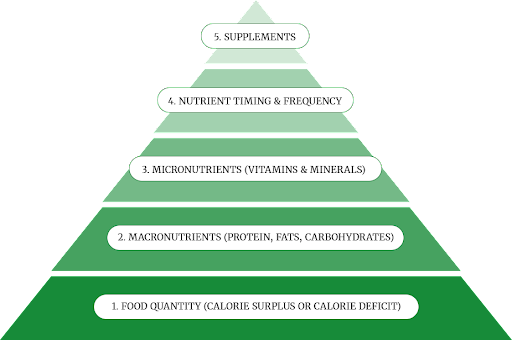Nutrition Protocol – Diet Tips
Embarking on a journey towards a healthier lifestyle involves more than just a temporary adjustment; it’s about adopting sustainable habits. When it comes to achieving your fitness goals, incorporating effective diet tips can make a significant impact. These tips go beyond mere calorie counting, focusing on nourishing your body, boosting energy levels, and supporting overall well-being. From mindful eating practices to strategic meal planning, let’s delve into a comprehensive guide of diet tips that can serve as a foundation for your path to a healthier you.
I frequently hear, “Are you the coach for the Paleo, intermittent fasting, or low-carbohydrate?” All of them and none of them is my reaction.
Personalization is my main concern, and you should be too. A growing body of data is being produced daily demonstrating how individualized nutrition is. While working toward your objectives, having the option to customize your eating routine, foods, and more will give you a true sense of independence.
Given our varied ethnic backgrounds, altered DNA, and shifting environmental influences, is there truly a single “correct way” to eat for everyone?
Without a doubt not, which explains why many struggles with their body composition and bad health indicators despite following general guidelines designed for a specific portion of the population, such as the ketogenic diet for those who benefit from a low-carbohydrate diet.
Personal nutrition involves taking into account more than just the latest diet fad or diet program you may have heard about.
Personal nutrition involves taking into account factors such as ethnic origin, DNA, the current environment, the time of year, the location, stress levels, toxin status, lifestyle, likes and dislikes, and personal preferences in addition to recommending a specific diet protocol you have read about or the latest trend.
Here are some facts:
Personal nutrition involves taking into account factors such as:
- Ethnic origin
- DNA
- Current environment
- Time of year
- Location
- Stress levels
- Toxicity status
- Lifestyle
- Likes and dislikes
Personal preferences in addition to recommending a specific diet protocol you have read about or the latest trend.

Discover How I Can Help You Lose Weight
How to meal prep – even if you don’t have any nutrition background!
A little-known way to lose weight – you’ll be amazed!
A stupidly simple trick for losing your belly fat.
What the professionals in fitness do when they want to lose weight.
The secrets of losing belly fat. This one will blow you away!

Present-day Philosophy
This test can be used on just about everyone. Inquire about their self-description as an “eating type.”
The frequent responses you will hear are “eat everything,” “Paleo,” “vegan,” “vegetarian,” “intermittent fasting,” “carnivore,” and “omnivore.”
Eating is a tribal activity, and we constantly yearn to fit in with or be a part of something. When we identify with a certain type or group, we become defensive about them and believe that our system is the greatest, which prevents us from seeing the big picture.
Personalization is the greater picture when it comes to nutrition. This is my issue with many of the current “popular diets”: many of them fail to take the user’s unique demands into consideration.
So Why Do They Function?
They Assist in Generating a Caloric Deficit/Superflux
First off, many of the themed diets (like Paleo, low-carb, and keto) work because they are indirect ways of creating a calorie deficit, even though it is not “printed on the box.” When you exclude processed foods from your diet (Paleo diet), it’s likely that your intake of fiber will rise and your consumption of refined carbohydrates will fall, which will leave you feeling fuller for longer.
Most people agree that the main factor determining whether you gain weight or lose it is the “calories in, calories out” equation. (Those that disagree are just out to make quick cash!)
No matter the ratio of your macronutrients, if you eat more than you require, you will gain weight (both muscle and fat), and if you eat less than you burn, you will lose weight (primarily fat, but some muscle too).
It is not possible to bypass or build muscle mass/lose weight by another technique. However, there are additional elements that can assist you in creating a deficit or surplus that are occasionally wrongly used as an alternative, such as low-carbohydrate diets. In order to provide the body with the energy and nutrition it needs to build new muscle tissue, we must eat more than we need when we wish to gain weight.
De Novo Lipogenesis is a mechanism that your body can use to create fat cells (adipose) from carbs, even if you avoid carbohydrates but continue to consume more energy than you burn each day (Think lipo – fat, Genesis – creation).
They Enhance Food Varieties (Macronutrient Balance)
Some contemporary dietary strategies put food first and concentrate on fully avoiding certain foods or food groups (e.g. Ketogenic diet). Some people adopt an additive strategy and ask you to substitute by adding nutrient-dense wholefoods (e.g. Paleo diet)
This guarantees they are eating a high-nutrient diet, which causes them to observe not just visual changes but also better health markers and athletic performance! This typically indicates that the individual has more energy to exercise and will do so more frequently.
Furthermore, this also
Longer intervals of feeling satisfied (full) between meals helps people control their calorie intake without using a calorie counter. This decreases overeating and increases the intake of all required nutrients.
They Increase Nutrient Intake (Vitamins and Minerals)
A healthy diet emphasizes the significance of getting enough daily micronutrients, such as water and fiber. This is exactly what many contemporary protocols advocate, emphasizing whole, single-ingredient diets. This guarantees an adequate intake of fruits and vegetables, which are essential for maintaining an adequate intake of micronutrients in the diet.
They Concentrate on Meal Timing and Frequency.
Numerous contemporary nutrition regimes instruct their users on the significance of nutrient timing, or when specific nutrients might be ingested to increase the effectiveness of the diet and facilitate performance adaptations (e.g., intermittent fasting) (e.g. post-workout protein intake).
For instance, everyone is familiar with the term “anabolic window.” Following exercise, our bodies become more sensitive to absorbing and utilizing specific nutrients, such as protein and carbs (depending on the type of exercise).
However, recent research indicates that the time of your post-workout smoothie won’t have much of an impact if your daily protein consumption is insufficient. When daily consumption is attained, it is ideal to give your muscles the vital amino acids they need to recover from exercise.
Many contemporary protocols will also provide dietary requirements that are consistent with their other suggestions, increasing user compliance.
Supplements
Navigating the world of supplements can be a key aspect of effective diet tips, enhancing your nutritional journey. While whole foods are the foundation of a balanced diet, supplements can provide targeted support to address specific needs. Incorporating the right supplements strategically can offer benefits such as bridging nutrient gaps, supporting workout recovery, and optimizing overall health. Remember, supplements should complement, not replace, a well-rounded diet.
Consultation with a healthcare professional or a nutrition expert can guide you in selecting supplements that align with your individual goals and dietary requirements. Integrating these diet tips related to supplements can contribute to a comprehensive and personalized approach to your nutritional well-being.
In addition to modifying someone’s eating habits and routine, many contemporary procedures also include some supplements.
We are aware of a number of supplements that have undergone field testing and have had their efficacy supported by research, but we must always keep the following two factors in mind:
Does the supplement’s quality fulfill approved manufacturing requirements and compliances in terms of both quantity and quality? Has the effectiveness of the supplement’s major ingredients been thoroughly studied at the levels recommended? You should skip the supplement and look for a better option if any of these conditions are not met.
Is the supplement safe and have all of its components been given the World Anti-Doping Association (WADA) seal of approval? If not, you should steer clear of the supplement and hunt for a suitable replacement. The danger is not worth it for them. This only applies, though, if you’re an athlete. The Food and Drug Administration (FDA) will have approved many supplements as being safe, but WADA will not. Adults don’t need to consume any substances that haven’t been approved by WADA; only athletes who are subject to testing must. With a few exceptions, you should stick to the supplements that WADA has allowed because they have undergone thorough testing and are proven safe.
When recommending supplements and, even more so, when comprehending some of the supplements linked to contemporary dietary guidelines, these two variables must always be taken into account.
The aforementioned data can be condensed into the pyramid below, where the base represents the foundation, which is the most crucial and moves upward to the top level.
Level 1 is attained by many contemporary dietary regimes, enabling manipulation of the user’s body composition. While some people will integrate levels 2 through 5, following all five levels consistently produces the best outcomes.
These are the basic elements of every plan. We must recognize that when we read success tales and endorsements from those who adhere to contemporary nutrition protocols like Paleo, intermittent fasting, etc., this is the result of the manipulation of 1 or more of these categories.

To accomplish this, several current nutrition regimes or “diets” employ a variety of prescriptions, limitations, or methods. As a result, even though they are all carrying out identical tasks (or working toward a very similar goal), they will all feel extremely different when doing so.
Nutrition Redefined
People’s initial aims and their responses to these protocols overtime must be taken into account when trying to match the correct nutrition plan for them.
Many people are only interested in making progress when the numbers on the scales or how their clothes fit, yet this is what is actually holding them back the most.
Therefore, I established standards that I always adhere to while advising my customers to follow a nutrition program or dietary strategy. Help children to recognize the other crucial indicators of development, such as energy levels, wellbeing, sleep, relationships with food, and others of a similar nature.
In my experience, doing so produces far better outcomes and contributes to the development of a long-term, productive atmosphere for achieving and maintaining a healthy, balanced diet.
This is due to the fact that we are shifting from a primary emphasis on how the individual looks to also taking their health and wellbeing into account.
Therefore, we must make sure that we respect and take into account how we respond emotionally as well as physiologically to them, whether we are establishing nutrition programs or simply adhering to existing ones that may or may not contain some of the modern nutrition protocols.
The best results will come from a dietary plan that effectively checks all of your boxes, and it will also increase the likelihood that the improvement will last over the long run.
Bodies With Better Composition
Whether it’s weight loss or simply looking fantastic naked, this is what the majority of people desire right away. Controlling energy balance is successful if body composition improves without the expense of the other two components and can be sustained.
Better Health
Many people are unaware that one of the main determinants of how their body appears is their health. We must comprehend the advantages of eating healthfully, which will enhance both our overall health and our body composition. Better mood, sleep, energy, confidence, and overall health should all be noticeable improvements.
Embracing diet tips is a fundamental step towards achieving better health and overall well-being. Incorporating nutrient-dense foods rich in vitamins, minerals, and antioxidants can significantly impact your physical and mental health. Choosing whole grains, lean proteins, and an array of colorful fruits and vegetables provides a diverse range of essential nutrients. Portion control is another vital aspect of diet tips, ensuring that you meet your nutritional needs without overindulging. Hydration plays a crucial role in supporting bodily functions, so incorporating plenty of water into your daily routine is a simple yet effective diet tip for better health. Remember, adopting sustainable dietary habits and making gradual changes can lead to long-term success in your quest for improved health through these diet tips.
Much Better Performance
Improved performance indicators should be another goal for our diet. They should be able to participate fully in all daytime activities, including sports, hobbies, and sports.
These three aspects should always be taken into account and monitored (based on feedback), especially when designing programs and thinking about the potential introduction of other protocols and procedures.
You can evaluate new protocols that you may hear about or learn about using this technique as well. Always consider how these will affect how they feel, look, and perform before implementing them.
Any decrease or reduction in any one of these three variables indicates that the person may not be the best candidate for the present dietary advice.
Conclusion
Embarking on a journey toward better health often involves navigating a plethora of diet tips. These invaluable pieces of advice serve as guiding beacons, steering individuals through the labyrinth of nutritional choices. At the heart of effective diet tips is the recognition that no one-size-fits-all approach exists. Every person is unique, and so too should be their dietary strategies.
One of the foundational diet tips is to prioritize whole, nutrient-dense foods. Vegetables, fruits, lean proteins, and whole grains should form the cornerstone of your dietary choices. The magic lies not just in what you exclude but in what you include. This principle emphasizes the positive aspect of nourishing your body with foods rich in vitamins, minerals, and antioxidants.
Another crucial tip centers on mindful eating. This involves paying attention to your body’s hunger and fullness cues, fostering a healthier relationship with food. Mindful eating encourages savoring each bite, understanding your body’s signals, and distinguishing between emotional and physical hunger. It’s not just about what you eat but how you eat.
Balancing macronutrients is a perennially relevant tip. Carbohydrates, proteins, and fats are the macronutrient triumvirate that fuels your body. Striking the right balance, tailored to your activity levels and health goals, ensures sustained energy, muscle maintenance, and overall well-being. These diet tips are not commandments but rather guidelines, allowing you to craft a dietary tapestry that aligns with your unique needs and aspirations.



0 Comments